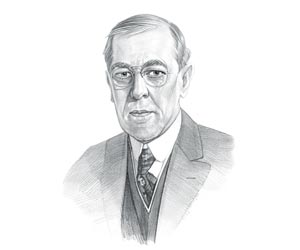|
|
|
|
|
The apparently small conflict rapidly spread to larger countries in Europe as Germany, Great Britain, Russia and France were all drawn into the war. The rapid spread and outbreak of WW1 was due to treaties and alliances that obligated them to defend certain other nations. The terrible conflict spread across the world. America joined the side of Allies on April 6, 1917 after Germany had violated American neutrality with its unrestricted U-Boat submarine warfare campaign. Eight million troops died and 21 million troops were wounded in World War One.
Outbreak of WW1 for kids: America remains Neutral
Outbreak of WW1 for kids
Outbreak and Causes of WW1 in
Europe for kids
Summary of Outbreak and Causes of WW1 in America for kids
For comprehensive information about the attitude of Americans prior to the outbreak and the detailed causes of the war in the US refer to our article on the American Entry into WW1. Facts about
Outbreak and Causes of World War 1 There was a tangle of treaties and alliances made between various European countries in order to maintain a balance of power in Europe. Alliances: In 1881 Germany made an alliance with Austria-Hungary and Italy agreeing to protect each other in the event they were attacked by France Secret Alliances: Italy went on to make a secret alliance with France saying they would not aid Germany Alliances: In 1892 France and Russia established an alliance in response to Germany's alliances. Alliances: Russia had signed an agreement promising to protect Serbia in the event of attack Alliances: In 1904, Britain and France signed a treaty Alliances: In 1907 the old enemies France, Britain, and Russia formed an alliance called the Triple Entente that stated that they had a 'moral obligation' to support each other. The Triple Entente was made to balance the growing power of Germany Nationalistic pride and politics, secret alliances and imperialism all played a part in the outbreak and causes of World War One, as did the rivalries of the countries and the jealousies between the leaders. The policy and practice of Imperialism saw European countries uniting the different territories of an empire with their own governments that adhered to the dominance of the 'mother country'. The Bosnian Crisis: The Bosnian Crisis erupted in 1909 when Austria-Hungary took over the former Turkish province of Bosnia infuriating Serbia The Moroccan Crisis - In 1911 Germany protested against the French possession of Morocco Countries in Europe were building and growing their military forces, arms and battleships Countries in Europe wanted to regain lost territories from previous conflicts and build new empires. The unstable system of alliances, distrust between the countries and conflicting secret treaties crashed down in the summer of 1914 when events led to the outbreak of World War One. World War One was triggered on 28 June 1914 by the assassination of the Archduke Franz Ferdinand of Austria (nephew of Emperor Franz Josef and heir to the throne of Austria and Hungary) and his pregnant wife Sophie The assassination of Archduke Franz Ferdinand took place in in Sarajevo, the capital of the Austro-Hungarian province of Bosnia and Herzegovina and was perpetrated by a Serbian terrorist group, called 'The Black Hand'. The name of the man who shot Archduke Franz Ferdinand and his wife was a Bosnian revolutionary called Gavrilo Princip. The assassination of Archduke Franz-Ferdinand and Sophie set off a rapid chain of events in Europe. However, the assassination took place with the knowledge of Serbian officials who hoped to start a war that would bring about the destruction of the Austro-Hungarian Empire. Austria-Hungary, and many other European countries, blamed the Serbian government for the attack. Russia had signed an agreement promising to protect Serbia in the event of attack so before taking action the Austro-Hungarian leaders sought assurances from German leader Kaiser Wilhelm that Germany would support their cause in the event of a Russian intervention (which was also likely to involve Russia's allies, France and Great Britain). Assurances were received from Germany and Austria-Hungary declared war on Serbia and the outbreak of World War 1 began on July 28,1914. World War 1 involved 2 opposing alliances - the Allies and the Central Powers The countries of the Allies at the outbreak included Russia, France, British Empire, Italy, United States, Japan, Rumania, Serbia, Belgium, Greece, Portugal and Montenegro The countries of the Central Powers at the outbreak included Germany, Austria-Hungary, Turkey and Bulgaria The terrible conflict spread across the globe in which 8 million soldiers died and 21 million troops were wounded. The USA entered the conflict and declared war on Germany on April 6, 1917. |
| US American History |
| 1913-1928: WW1 & Prohibition |
|
|
|
|
|
First Published2016-04-19 | |||
|
Updated 2018-01-01 |
Publisher
Siteseen Limited
| ||
|
|

